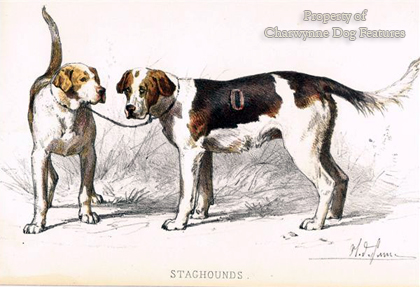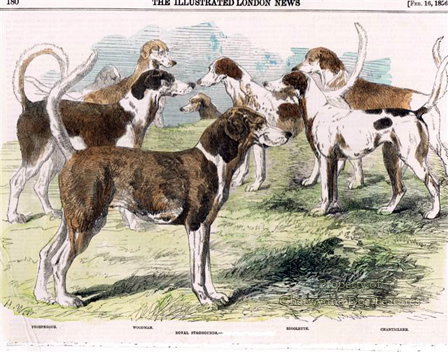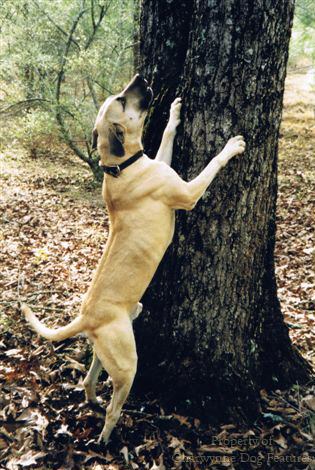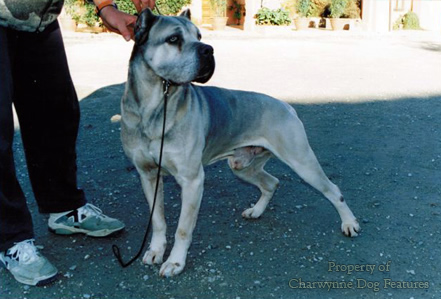424 Recasting Hounds
RECASTING HOUNDS
by David Hancock
 Time and time again, writers of books on the hound breeds inform their readers that hounds hunt either by scent or by sight and that hound breeds fall into just two categories: scenthounds or sighthounds. Such an arbitrary division is not only misleadingly superficial but does scant justice to many distinguished hound breeds or those hounds, such as the podengos of the Mediterranean littoral which pursue their quarry using sight and scent. If you elect too to divide sporting dogs into hounds, terriers and gundogs, how do you then allocate hounds which hunt for the gun (chasse a tir), bark-pointers or say Airedale Terriers used in hunting trials in the USA? The classification of quarry hounds, especially by kennel clubs, has often been conducted in a lazy, ill-informed manner, unsupported by research or insight and badly needs rectifying.
Time and time again, writers of books on the hound breeds inform their readers that hounds hunt either by scent or by sight and that hound breeds fall into just two categories: scenthounds or sighthounds. Such an arbitrary division is not only misleadingly superficial but does scant justice to many distinguished hound breeds or those hounds, such as the podengos of the Mediterranean littoral which pursue their quarry using sight and scent. If you elect too to divide sporting dogs into hounds, terriers and gundogs, how do you then allocate hounds which hunt for the gun (chasse a tir), bark-pointers or say Airedale Terriers used in hunting trials in the USA? The classification of quarry hounds, especially by kennel clubs, has often been conducted in a lazy, ill-informed manner, unsupported by research or insight and badly needs rectifying.
All hounds hunt by sight and scent. Some are utilised so as to make best use of their speed; they succeed principally because of their speed not their sight. Some are prized because of their scenting skill; they succeed mainly because of their stamina ahead of their scenting prowess. If either type cannot keep up with their quarry they don't succeed, even if they continue to see it or scent it. The phenotype of the so-called sighthounds is epitomised by that of the Greyhound, that of the so-called scenthounds perhaps by the Bloodhound. But what about the 'par force' hounds, which hunted at pace using their sheer power, utilising sight and scent in equal measure?
In medieval hunting, the par force hunt was more like a steeplechase, with drive valued more in hounds than their music. In time this style became less favoured than hunting in enclosed parks, really an ill-disciplined form of coursing, and 'hunting cunning' in which slow hounds were prized for their skill in unravelling scent. But hunting with 'fleethounds' continued in the north of England despite changes in style further south. Par force hounds, fleethounds or 'running mastiffs' are perpetuated today in breeds like the Great Dane, the Dogo Argentino, the Rhodesian Ridgeback and, in the United States, by the Black-Mouthed Cur, whatever their classification by kennel clubs. 
A further type of hound was the 'hunting mastiff', used to close with and either seize or pull down big game such as boar, wild bull, auroch and stag. The 'bandogge' was the mastiff-like catch-dog. Many were killed by their quarry. They were often ferocious and therefore held on leashes in the hunt, for release only when the baying hounds had done their job. This is why they were called bandogges (band+dog). It was not because they were tethered guard-dogs or tied-up yard-dogs as some writers have claimed. Undoubtedly some bandogges found employment as guard dogs on chains in yards. But there is an old English ballad of around 1610 which includes these lines: "Half a hundred good band-dogs, Came running over the lee." There is little indication of solitary tied-up yard-dogs in these words.
Further confusion has arisen through the misuse of the word 'gazehound'. So many writers seem to see the word as a synonym for sighthound; it is not. Dr Johannes Caius, in his classic treatise 'Of English Dogs' of 1576, made quite separate mention of the Greyhound and the Gazehound; he did not regard the former as embraced by the latter. His words on the gazehound are worthy of study. "Our countrymen call this dog Agasoeum, a Gazehound: because the beams of his sight are so steadfastly settled and unmovably fastened...Horsemen use them more than footmen, in the intent that they might provoke their horses to a swift gallop...and that they might accustom their horse to leap over hedges and ditches..." That is a clear description of par force hunting, a steeplechase with a pack of fast-hunting hounds. It is hardly a description of hunting with sighthounds.
Nicholas Cox, in his 'The Gentleman's Recreation' of 1674 (predictably using other peoples' material, in this case Caius), mentions gazehounds as "used for catching the fox and hare, hunting chiefly by sight in open country, employed by people riding." He too lists the Greyhound quite separately. Thomas Bewick, in his 'History of Quadrupeds' of 1790, stated that the gazehound "was somewhat similar to the greyhound...It was formerly in great repute, but is now unknown to us." Bewick was not an authority on dogs and had little knowledge of hunting. His full text is a lift from Caius. 'Stonehenge', in his 'The Dog' of 1867, states that Bewick "does not appear to have any authority for what he writes on this particular." But he himself wrote: "This breed is now lost, and it is very difficult to ascertain in what respects it differed from the greyhound"; words not markedly different from Bewick's.
The word gazehound never, of course, referred to a breed but to a function, rather as the word sighthound does. Hounds in the Middle Ages were used on all sorts of game, without specialisation. In 1318, Philippe VI authorised all noblemen to hunt big game 'by force and cunning' to distinguish it from stealth and ambush hunting, using nets and spears. This hunting at pace using the strength of the hounds, not surprisingly, led to the breeding of faster stronger hounds, hunting in packs. In his 'Hounds in Old Days' of 1913, Sir Walter Gilbey wrote: "The old plan, advocated by Cockaine in 1591, of breeding a pack that should hunt any and every quarry, had so completely gone out of use in Beckford's time (i.e. late 18th century) that the practice of a friend of that authority who possessed a pack of large fleet hounds, which at times had hunted all game -- red and fallow deer, fox and hare -- was regarded as 'very extraordinary' ".
Specalisation, of course, brought our surviving breeds of hound to us; although today staghounds are really only Foxhounds with a different purpose and minkhounds can be 'recycled Foxhounds' or re-employed Otterhounds. In many ways each Foxhound pack constitutes a separate breed of Foxhound. It would be an enormous pity if we were to lose the varying pack-idiosyncrasies as well as the constructional subtleties of the different packs. With hunting using dogs under threat, we need to give thought to the conservation of our hounds of the pack; they are very much part of our sporting, and canine, heritage.
Any move towards the recognition, of hounds, in groups, as: those which hunted by speed, those which hunted by stamina, those which hunted 'at force' and those which seized big game i.e. the mastiff breeds, would be resisted by kennel clubs. They prefer the status quo in most matters. Show breeders too seem to fear innovation. But the recognition of the Mastiff, the English breed, as a heavy hound, would undoubtedly do it some good. I do wish the Mastiff fraternity could shed the mistaken Victorian concept of their breed as a massive slothful inactive yard-dog and rekindle the long sporting heritage of this type of dog. No real dog man would ever prize his dog because of its weight and size.
"A mastiff is a manner of hound" wrote the second Duke of York in his 'The Master of Game' of 1410. "Mastiffs were still kept as guard-dogs, but their value in hunting disappeared with the wild boar" wrote Roger Longrigg in his 'The English Squire and his Sport'. "The mastiff is a huge, stubborn, ugly and impetuous hound" wrote William Harrison in his 'Description of England' of 1586. "...those of the mastiff type -- the massive dogs -- which attack the larger animals in the hunt" wrote the Fiennes in their 'The Natural History of the Dog'. "In the very specialized circumstances of the Tudor animal fight, the mastiff was really very much at a disadvantage. It had never been bred, originally, as an animal-fighting dog at all. It was a hunting dog" wrote Carson Ritchie in his 'The British Dog'. In the light of these quotations, why is our Mastiff breed so miscast? What breed of hound was ever raised like beef?
If we continue to miscast the Mastiff (and the Great Dane, still languishing in the Kennel Club's Working Group, despite its boarhound ancestry), and fail to acknowledge that there were hound functions beyond purely sight and scenthounds, then we undermine the rich heritage of our distinguished breeds of dog. Running mastiffs/fleethounds/gazehounds like the Rhodesian Ridgeback hunted with their heads up, seeking air scent. Hunting mastiffs/holding dogs/seizers like the Dogue de Bordeaux carried their heavier heads lower, ready to close with their quarry. Stamina hounds like the Basset moved with their noses to the ground, pursuing the scent of their prey. The speedsters, like the Greyhound and the Saluki, eyed the middle distance, striving to spot animal movement. These functions should affect how we allow our hounds to move in the ring, how we judge their anatomies and how we must strive to meet their spiritual needs. We bred them for a function. 
I look forward to the day when, at a Houndshow or at The Game Fair, a parade of hounds is accompanied by this commentary: "And now, Ladies and Gentlemen, we welcome into the ring our precious hound breeds. First come those which hunted by speed: the Whippet, the Greyhound, the Saluki, the Borzoi and the Deerhound. Then those which hunted by stamina: the Basset, the Beagle, the Foxhound and the Harrier . Next come those which hunted 'at force': the Great Dane, the Rhodesian Ridgeback, the Dogo Argentino and the recently introduced Black-Mouthed Cur from America. Finally, the holding dogs, the hunting mastiffs: the Dogue de Bordeaux, the Fila Brasileiro, the Cane Corso and, last but hardly least, the British Bulldog!"
Our British Bulldog in a parade of hounds, there's a thought! They'd have to be leggier, longer-muzzled and more active to complete the circuit and wouldn't that be a good thing? We may no longer wish our Mastiff and Bulldog to pull down big game any more but that is what they were designed to do. And if we went back to the physique which allowed them to do so they would be healthier breeds for it. Redundancy should not mean slow decline; it should represent a time to honour past service and respect true heritage. Surely the great joy in owning a hound is to allow it to take part in houndwork. And before that comes the need to know what our hounds were for. If we lazily divide our hound breeds into sighthounds and scenthounds only, we ignore centuries of hound activity across a wide spectrum. It's time we respected the hound heritage and stopped lumping types together for administrative ease; that's hardly sporting!